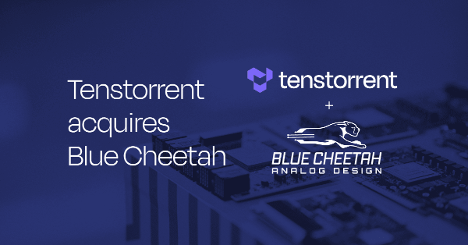Tenstorrent has acquired analog IP developer Blue Cheetah to bring die-to-die interconnect and analog design expertise in-house, advancing its chiplet-based architecture road map. The acquisition builds on an earlier IP licensing agreement and gives Tenstorrent direct control of BlueLynx interface technology, supporting both BoW and UCIe standards. The move aligns with Tenstorrent’s goal of enabling a modular chiplet ecosystem through its Open Chiplet Architecture (OCA), fostering interoperability while reducing dependency on third-party vendors. Blue Cheetah will continue offering OCA-compatible IP to external customers.
Tenstorrent announced it has acquired Blue Cheetah Analog Design, a start-up building highly customized analog mixed-signal IP.

(Source: Tenstorrent)
Blue Cheetah has played a crucial role as a technology partner for Tenstorrent, providing interconnect IP vital to the company’s development of chiplet-based architectures. The recent acquisition builds on Tenstorrent’s previous announcement that it licensed Blue Cheetah’s die-to-die interface IP for integration into its RISC-V and AI-focused chiplet platforms.
The transaction integrates Blue Cheetah’s analog and mixed-signal engineering capabilities directly into Tenstorrent’s organization. These skills are essential for enabling reliable and efficient communication between chiplets, especially in systems focused on AI and high-performance computing workloads. As the importance of analog and mixed-signal subsystems grows in chiplet-centered architectures, Tenstorrent’s choice to bring these capabilities in-house highlights a focus on performance, integration, and aligning with its long-term product road map.
The integration of Blue Cheetah’s design expertise enhances Tenstorrent’s ability to customize interconnect solutions for specific use cases. This move also supports the company’s broader goal of creating an open chiplet ecosystem, where standardized, socket-optimized interconnects enable scalable and modular silicon designs.
Tenstorrent’s acquisition of Blue Cheetah enhances control over chiplet design, interconnect technologies, and integration with compute and memory components. By bringing key IP and engineering resources in-house, Tenstorrent aims to reduce reliance on external vendors for analog parts and improve coordination between physical and architectural layers. The deal includes Blue Cheetah’s die-to-die interconnect IP, such as BlueLynx, now owned by Tenstorrent. Previously licensed in February 2024, BlueLynx supports PHY and link-layer interfaces, and can be configured for both BoW (Bunch of Wires) and UCIe (Universal Chiplet Interconnect Express), strengthening Tenstorrent’s foundation for modular silicon development.
Control over key IP like interconnect technologies has become a strategic priority for companies developing heterogeneous chiplet platforms. Tenstorrent’s decision to bring Blue Cheetah’s capabilities in-house demonstrates its goal to reduce dependencies and technical risks as it advances its silicon road map.
The acquisition supports the ongoing development of Tenstorrent’s Open Chiplet Architecture (OCA), which aims to enable interoperability across chiplets through open specifications and shared design frameworks.
Open Chiplet Architecture
Blue Cheetah will continue to develop and license IP to external customers. However, future products must remain compatible with Tenstorrent’s OCA-based ecosystem. According to a company representative, Blue Cheetah may also price certain OCA-compatible IP products to encourage adoption of Tenstorrent’s ecosystem. Use of these IP blocks does not require pairing with Tenstorrent chiplets, which preserves some level of architectural neutrality for potential partners.
Alongside the acquisition, Tenstorrent has released the specifications for OCA, its internal chiplet architecture framework. The goal is to enable an open, multi-vendor chiplet ecosystem where companies can combine and use interoperable silicon components based on their specific design needs. The company is currently establishing an official OCA organization and standardization process.
Chiplet-based design relies on interoperability across multiple system levels. OCA defines the electrical, protocol, and software interfaces needed for plug-and-play chiplet integration. This approach allows designers to reuse core components like DDR or PCIe interfaces while focusing their engineering efforts on unique elements. For example, by pairing the same AI chiplet with different memory interfaces, such as LPDDR or GDDR, a company can deploy that single component in both its edge and data center products.
Over the past three and a half years, Tenstorrent reports it has invested between $250 million and $300 million in chiplet-related R&D. The company plans to tapeout three compute chiplets this year that conform to the OCA specification. These will serve as foundational components in what it hopes will become a broader market for composable silicon.
Interest in die-to-die interconnect technology continues to grow as semiconductor companies aim to expand their product lines with chiplet-based solutions. In a related development, Qualcomm acquired Alphawave last month, positioning itself to boost its capabilities from mobile SoCs to chiplet-based data center CPUs and neural processing units.
Tenstorrent’s announcements mirror broader industry trends in modular silicon, supply chain control, and ecosystem development. By integrating IP ownership, standards setting, and open participation models, the company aims to position itself as a key player in emerging chiplet markets.
LIKE WHAT YOU’RE READING? INTRODUCE US TO YOUR FRIENDS AND COLLEAGUES.